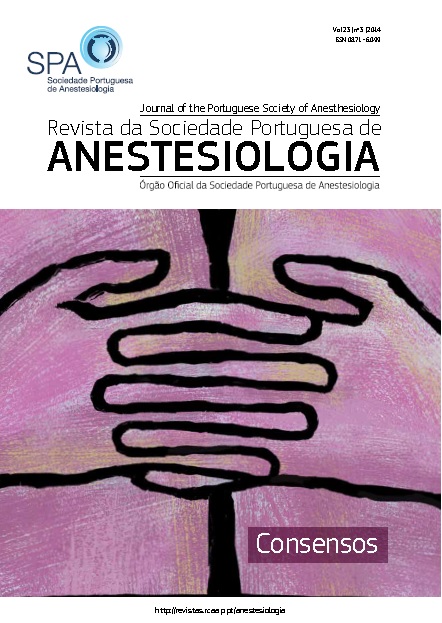Recomendações Perioperatórias para Profilaxia do Tromboembolismo Venoso no Doente Adulto. Consenso Nacional Multidisciplinar 2014
DOI:
https://doi.org/10.25751/rspa.4831Palavras-chave:
Consenso, Cuidados Peri-operatórios, Tromboembolismo Venoso/prevenção & controloResumo
O propósito destas recomendações é fornecer uma ferramenta fundamentada na evidência científica atual, centrada no doente, que possa ser útil na prática clínica e que contribua para a implementação adequada, sistemática e transversal da profilaxia do tromboembolismo venoso no doente adulto. Foram aprovadas, com o apoio da Sociedade Portuguesa de Anestesiologia, por Consenso Nacional Multidisciplinar entre as especialidades de: Anestesiologia, Cardiologia; Cirurgia Cardiotorácica; Cirurgia Geral - Cirurgia da Obesidade; Cirurgia Plástica, Reconstrutiva e Estética; Cirurgia Vascular; Ginecologia e Obstetrícia; Imuno-Hemoterapia; Neurocirurgia; Oncologia; Ortopedia e Urologia.
O tromboembolismo venoso constitui um grave problema de saúde pública. No período peri-operatório o risco de tromboembolismo está relacionado com fatores individuais do doente, tipo de cirurgia e de anestesia e tempo de internamento. Trombose venosa prévia, doença oncológica, idade avançada, cirurgia major ortopédica, cirurgia bariátrica e imobilização no leito, constituem alguns dos principais fatores de risco de eventos tromboembólicos. O bloqueio do neuro-eixo está associado a redução destes eventos.
O estudo ENDORSE que avaliou o cumprimento internacional das recomendações do 7º Consenso do American College of Chest Physicians sobre profilaxia do tromboembolismo venoso, revelou que em Portugal a taxa de profilaxia adequada no doente cirúrgico em risco era inferior à de outros países europeus. Neste estudo, alguns dos doentes a quem foi prescrita tromboprofilaxia não preenchiam critérios de indicação, ficando expostos a riscos desnecessários. Os hiatos identificados na profilaxia do TEV relacionam-se com a falta de comunicação interdisciplinar efetiva, desconhecimento das recomendações e da farmacologia dos agentes e o receio de complicações hemorrágicas. A falta de modelos de avaliação de risco validados e fáceis de aplicar tem dificultado a uniformização de critérios. Estas recomendações consideram o modelo de avaliação de risco de Caprini.
A avaliação do risco de tromboembolismo venoso está indicada em todos os doentes propostos para cirurgia, devendo ser registada no processo clínico. A tromboprofilaxia é uma responsabilidade multidisciplinar, deve basear-se na ponderação dos riscos de tromboembolismo venoso e de hemorragia e ter em conta os valores e preferências do doente.
A tromboprofilaxia deve iniciar-se 6-12 horas após a cirurgia (com exceções).
Downloads
Downloads
Publicado
Como Citar
Edição
Secção
Licença
Os artigos estão livremente disponíveis para serem lidos, descarregados e partilhados a partir do momento da sua publicação.
A RSPA reserva-se o direito de comercialização do artigo enquanto parte integrante da revista (na elaboração de separatas, por exemplo). O autor deverá acompanhar a carta de submissão com a declaração de cedência de direitos de autor para fins comerciais.
Relativamente à utilização por terceiros a Revista da SPA rege-se pelos termos da licença Creative Commons “Atribuição – uso Não-Comercial (CC BY-NC).
Após publicação na RSPA, os autores ficam autorizados a disponibilizar os seus artigos em repositórios das suas instituições de origem, desde que mencionem sempre onde foram publicados.


